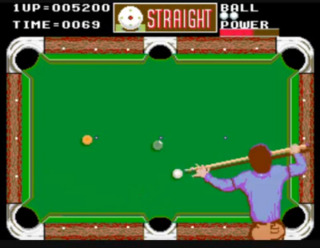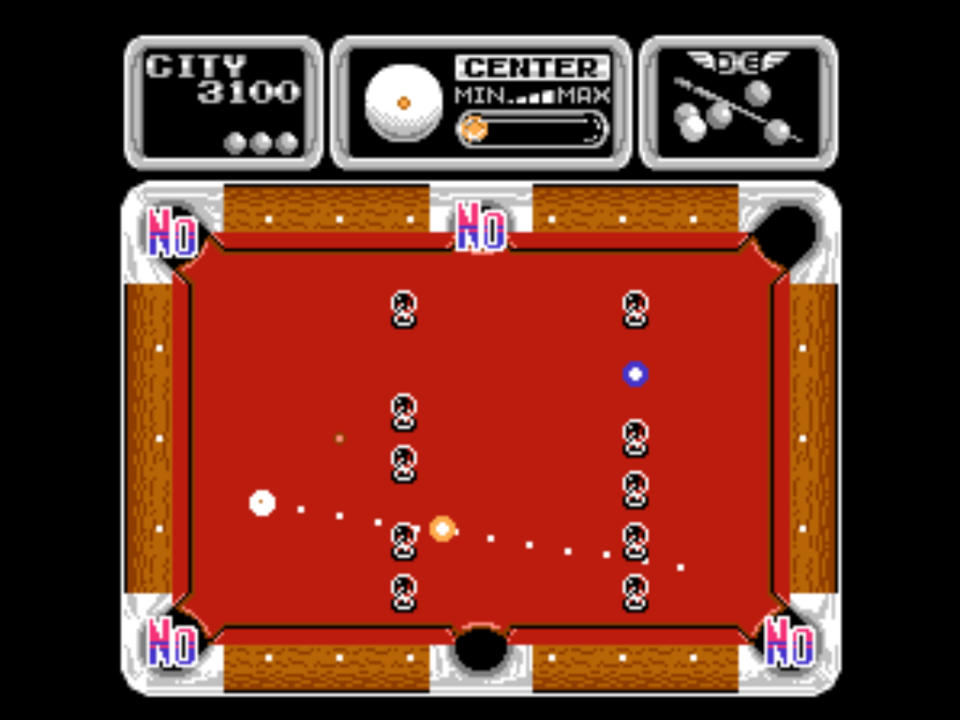Overview
 The original arcade version of the game, and the only one to show the player character making the shot in whole.
The original arcade version of the game, and the only one to show the player character making the shot in whole.Side Pocket is a top-down billiards game developed and released by Data East for arcades in June 1986.
One of the earliest arcade pool simulators released for arcades, Side Pocket builds on the formula of other top-down billiards games (such as Video Hustler and Super Billiards) by introducing several gameplay mechanics that were later made standard (including the use of rotation instead of a free-form cursor, a preview trajectory for the cue ball, and the ability to alter which part of the cue ball is hit for spins and trick shots).
The game's standard mode, later known as "Pocket Game", has players attempting to pocket all balls (other than the cue ball) on the table with a limited amount of lives (or "balls"), with bonus points awarded both for consecutively pocketing balls and for pocketing balls in sequence. In addition, players are given opportunities to sink a ball at a designated pocket to earn bonus points, bonus time, or bonus lives. It also features a post-round mini-game where players have one chance to make a specific trick shot. Home releases added the game of 9-Ball as an alternate multiplayer mode.
The game was later ported to the Nintendo Entertainment System in 1987, the Game Boy in 1990, the Sega Genesis in 1992, the Super Nintendo Entertainment System in 1993, and the Game Gear in 1994. These versions include various improvements, such as a new single-player progression system (where players progress by having high-scoring rounds), an improved spin system (with fine-tuned shots, massé shots, and jump shots), and new gameplay mechanics (such as "super balls" and "zones").
Along with its eroge spin-offs Pocket Gal and Pocket Gal Deluxe, the game received three sequels in Japan: Side Pocket 2: Densetsu no Hustler (which was released in North America as Minnesota Fats: Pool Legend), Side Pocket 3 (which brought the series into full 3D), and Side Pocket for WonderSwan. The original arcade version was also included in the Wii compilation Data East Arcade Classics.
Gameplay
 The NES version of the game, showing the Trick Shot mini-game. Can you figure out the right spin to sink both balls correctly?
The NES version of the game, showing the Trick Shot mini-game. Can you figure out the right spin to sink both balls correctly?In Side Pocket, players control each shot of the cue ball in a top-down perspective (similar to other pool simulation games of the time). Before each shot, players have three options:
- They can select which direction to hit the cue ball using the joystick, with a handy dotted line to indicate its trajectory. For precise aiming, the game has players holding down the joystick in a particular direction to begin rotating the cursor towards it.
- They can use the Spin button and the joystick to change which part of the ball to spin it. Home ports build upon this by allowing multiple levels of each type of spin (including hidden massé shots). Left/Right shots curve the ball in either direction once it hits an object, Draw shots has the cue ball retreat once it hits an object, and Follow shots has the cue ball push forward once it hits an object. Massé shots are unique in that it has the cue ball spin backwards (and optionally left/right) soon after it is shot, and can also be used to launch the ball into the air over other balls.
- They then perform the shot itself by hitting the Shot button (to start the Power Meter). The Power Meter swings left and right, and players press the Shot button to lock-in the power of the shot and hit it. In some versions, players can cancel the shot using a Cancel button.
Pocket Game
 One of the later console ports of the game.
One of the later console ports of the game.In the standard "Pocket Game", players start each set with one of two alternate racks of balls: six balls in a standard pyramid formation (similar to the game of 6-Ball) or nine balls in a thin diamond formation (similar to the game of 9-Ball). Home versions also include a ten-ball pyramid formation (similar to the games of 8-Ball and 10-Ball). Players can pocket each ball in the rack any order, and the set ends when all of these balls are pocketed.
Similar to other billiards games at the time, players have a limited amount of shots (or "balls") that deplete if the player either pockets the cue ball (for two shots) or fails to pocket any other ball (for one shot). Pocketing the cue ball also causes the other pocketed balls in that shot to return to the table. In addition, the Arcade version of the game has a timer that slowly depletes when the player is figuring out their shot (and can be replenished by pocketing balls). Once the timer or allowed shots depletes, the credit ends and players must add additional credits to continue. In Home versions, there is no timer and players are given more shots to start out with, but players cannot continue.
At certain times in the round, one pocket is highlighted and if players pocket a ball in there, they receive bonus points. In the Arcade version, this can be bonus time. In single-player modes, this can be bonus balls. In Home versions of the game, having one racked ball remaining causes one pocket to highlight as the "Zone" and players can hit their cue ball in there to enter a special state where if they pocket the final ball in that shot, they earn additional bonus balls. In addition, the Home versions include a "super shot" where at certain times, hitting the 9-Ball or 10-Ball causes the table to have less friction (making the shot more hectic).
In addition to points earned by pocketing balls and by bonus points, players are scored after each set by each sequence of balls pocketed consecutively and by each sequence of balls pocketed in a numerical sequence, with longer sequences earning more points. In Home versions, high-scoring sets are required to progress through the game. The game also includes a bonus "trick shot" between sets, where the table is set-up in a particular way (usually with obstacles) and players must pot balls in specific pockets without hitting obstacles in order to gain additional bonus points.
In two-player multiplayer matches, players attempt to end a multi-set match with the highest score (with no "trick shot" mini-game). Players do not have a limited amount of balls to work with, instead switching between each player once they either pocket the cue ball or fail to pocket any ball. The Home versions do not include Super Shots or Zones.
9-Ball
In the Home versions, players can instead choose to play the game of 9-Ball in multiplayer (with the NES and GB versions allowing a one-player "training" variant). As it plays closer to the traditional rules of pool, this mode features some significant differences:
- The game uses the nine-ball diamond formation rack. While players can pocket any ball, they must hit the lowest-numbered ball first (or else the shot is fouled). When the 9-Ball is pocketed and the cue ball is not also pocketed, the player wins the set.
- Similar to multiplayer Pocket Game, both players start the game by banking to determine who goes first. Additionally, players alternate turns each time they fail to pocket a ball.
- When a player either fails to hit the lowest-numbered ball first or pockets the cue ball, they receive a penalty. All balls pocketed are re-racked and the opposing player can choose where to put the cue ball. Players who reach three consecutive penalties (shown as "stocks') must forfeit the round.
- Super Shots, Zones, and Bonus Pockets are disabled. Players are no longer scored and are instead tracked on the amount of sets won.
Ports
The game was first ported to the Nintendo Entertainment System in North America on June 1987 (with a Japanese release by Namcot on October 30, 1987 and a European release on May 27, 1992). This version introduces most of the gameplay improvements standard with the home ports and was used as the base for Pocket Gal.
The game was then ported to the Game Boy in Japan on September 21, 1990, with overseas version released later that year. It features two-player linked multiplayer and was later digitally re-released for the Nintendo 3DS as a Virtual Console title by G-mode in 2011 (September 7 in Japan, October 6 in North America, and November 10 in Europe).
The game was then ported to the Sega Genesis in 1992, including the graphics from Pocket Gal Deluxe. This version includes a variety of graphical and audio upgrades while adding a new game mode specifically for trick shots (as "Trick Game'). This version was later ported to the Super Nintendo Entertainment System (by Iguana Entertainment) in 1993-1994 and to the Game Gear exclusively in North America in 1994. It was also used as the base for both the game's sequel and Pocket Gal Deluxe.
Log in to comment